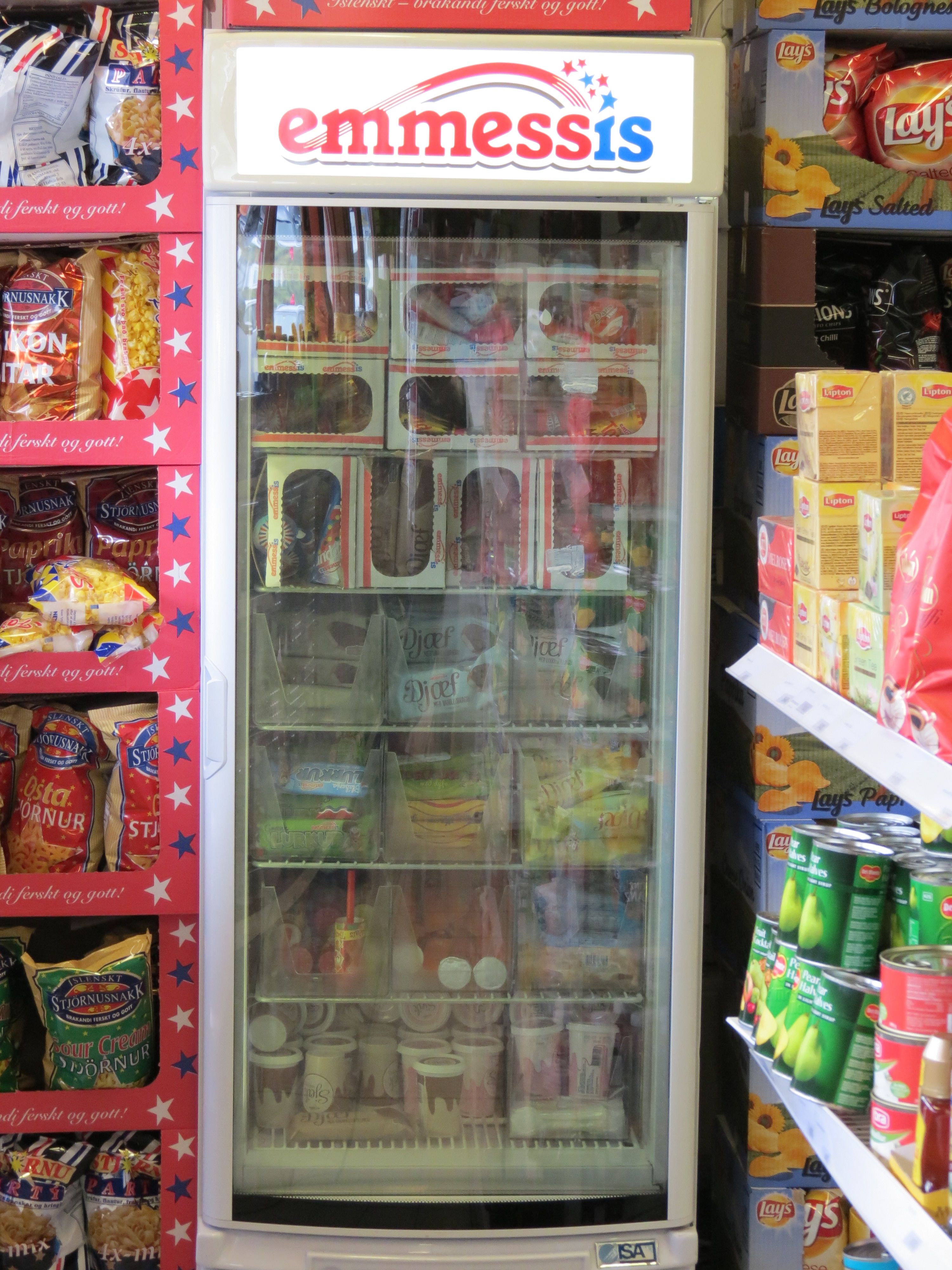
|
–Geoff-Hart.com: Editing, Writing, and Translation —Home —Services —Books —Articles —Resources —Fiction —Contact me —Français |
by Geoff Hart
As the title says, today was our day for returning to Reykjavic and thence home. A long drive, since we were starting from as far from Reykjavic as we’d reached in several days of relocations while moving progressively farther south and east. Being a wise man, Dick arranged for several stops along the way to break up the trip, give us a last taste of a few things uniquely Icelandic, and let us stretch our legs. At one bathroom stop, I snagged a fast food burger at a truck stop. It was actually pretty good, but very much fast food. I also snagged an ice cream, though not the brand with the ill-omened name shown in this photo:

(For the non-word-geeks in the audience: “emesis” is the act of vomiting.)
As in previous days, the morning started out unpromising, with clouds and rain, but by the time we got to the tourist stops, the clouds had withdrawn to lurk in the background so that we could enjoy the scenery. Our first non-bathroom stop was at another beach of black sand (from eroded basalt). Here, the primary attractions were a different look at the sea-pierced rock we’d seen several days earlier and a closeup look at some distinctive basalt columns. The latter were similar to those that we’d seen the previous day at Svartfoss, but bigger and more distinct, and there was also some unusual shale-like basalt that formed thin, flaky layers. The columns were distinct and impressive, enough so that a Chinese couple was having their wedding photos taken in a cave that had waves had carved out of the bottoms of the columns. Here's a view of the columns, with a few of our group for scale, and of the couple being photographed:
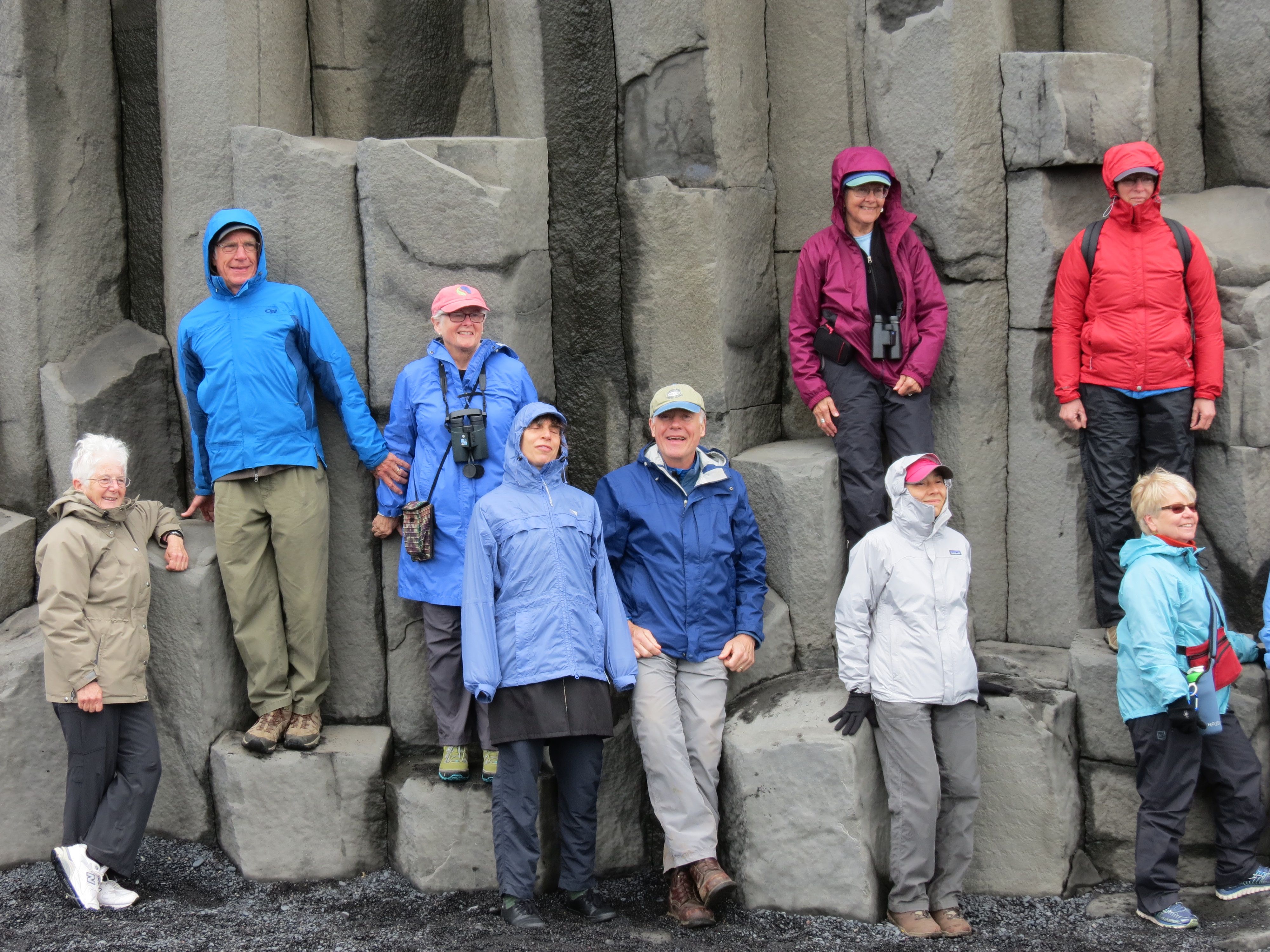
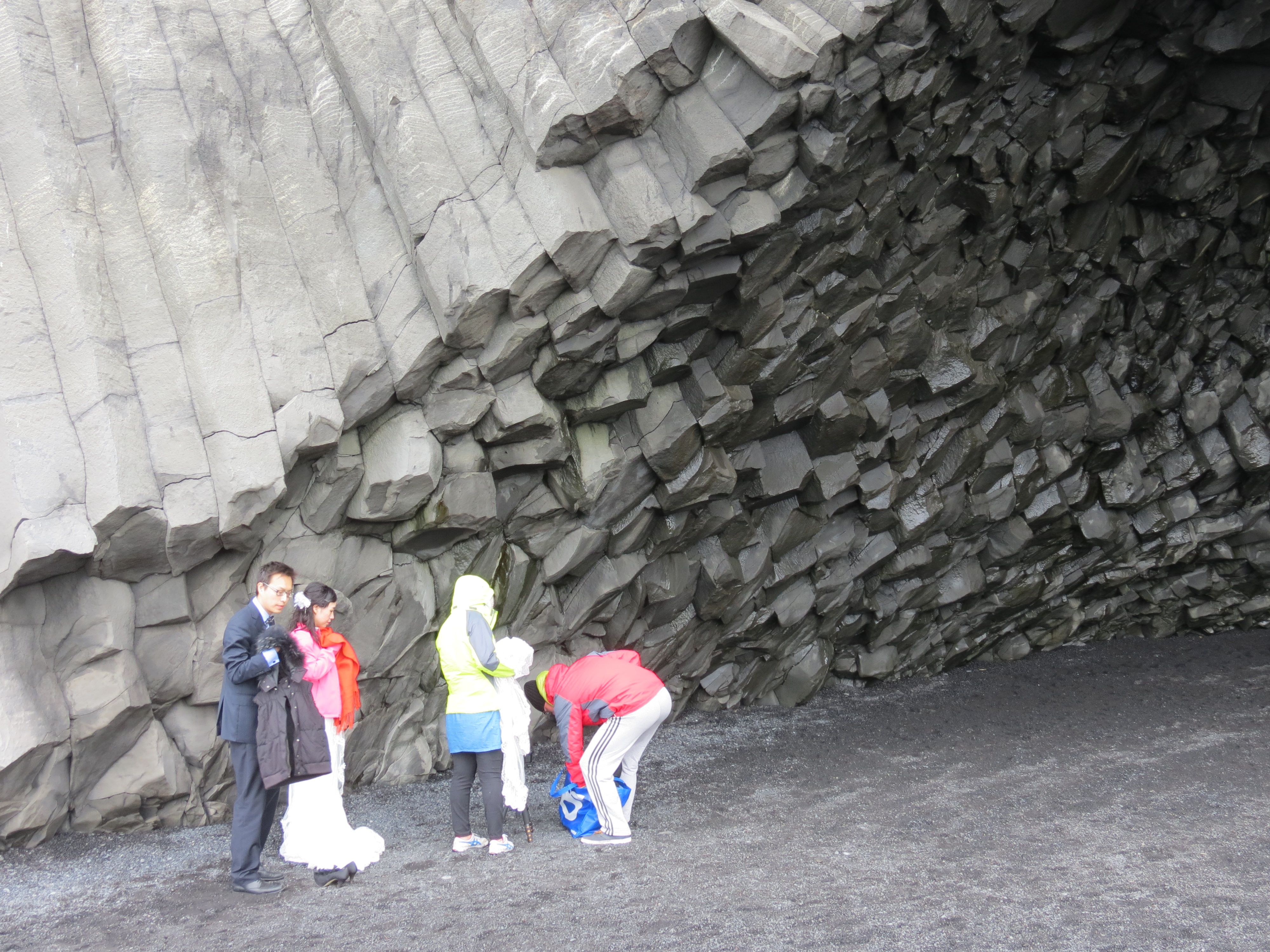
Our next stop was a museum directly below Eyafjallajökull, created by the farm family who’d lived below the volcano for three generations. They’re still there, even after the massive eruption in 2010. In fact, if you didn't know what had happened, you'd never know anything was amiss just from looking around; it's amazing how fast the vegetation recovers after an ash fall, and Icelanders apparently clean away inches of ash the way snowbelt folk deal with blizzards. The family was fortunate that most of the eruption occurred far enough inland that most of the glacial meltwater ran inland, and thereby spared their farm from being washed into the north Atlantic. As it was, the farm was buried in inches of ash and the family had to evacuate, but in the end they were able to return and perform the huge cleanup job to get their lives back in order. It's a fascinating example of how hard people will fight for what they’ve built over the generations and, when the volcano gods are merciful, how they can succeed.
The film that described their struggle and eventual victory seems to me a quintessentially Icelandic story: working hard in the face of difficult odds, even knowing that you could fail purely by bad luck despite your best efforts. The film also included some spectacular footage of the eruption, with fountains of lava, billowing ash clouds, and long views over the ice cap atop the volcano. The descent of a helicopter into the crater once the eruption had ceased brings home just how big a deal this was: it seemed as long as the Star Wars sequence in which Luke Skywalker flies into the Death Star’s trench, and I’m sure the cinematography deliberately evoked that image. Here’s a shot of the family farm, with the icecap-hidden volcano looming dramatically in the background:
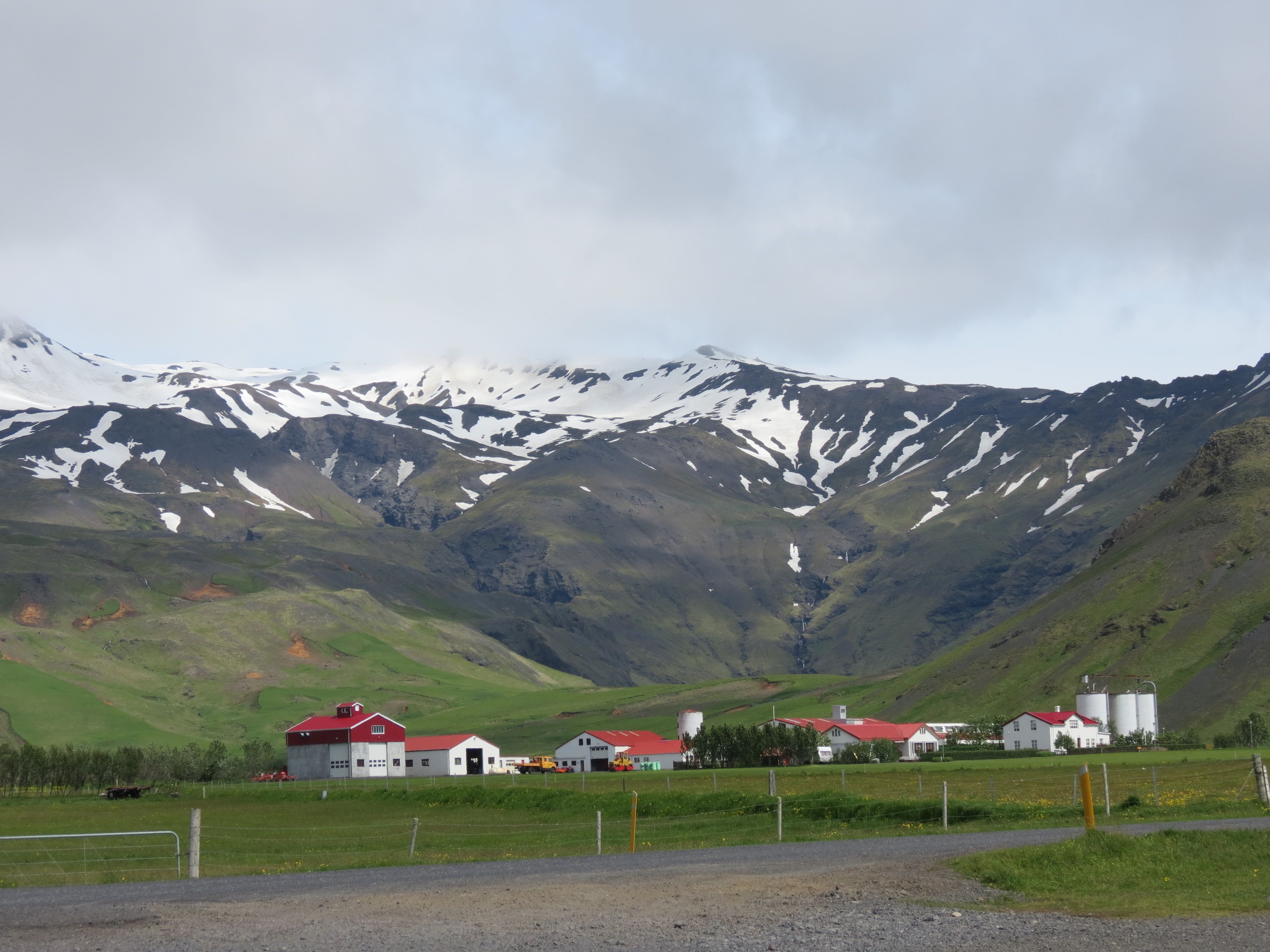
Our final stop before Reykjavic was the geothermal power plant at Hellisheitharvirkjun. It’s an impressive facility that covers several acres just in the area immediately surrounding the visitor center, but with boreholes and piping stretching for miles around the actual buildings. There are giant steam-driven turbines (they “dry” the steam first by removing liquid water), cooling towers, and other heavily industrial appurtenances. The visitor center has a short video that explains the layout of the complex, and it's a plumber's nightmare. But it all works somehow. The efficiency of steam usage is high: well over 90% of the steam is captured and used to generate power, with the rest vented to relieve overpressures in the system. The plant delivers heated water at about 80°C (almost 180°F) to all homes in Reykjavic using a 3000-km (about 1864 miles) network of pipes. Over the ca. 11 km it travels into town, it loses only about 2°C in temperature, which is remarkable. A signboard suggests that during peak hours, these pipes deliver 16000 tons of water per hour to Reykjavic, which is enough to fill 440 oil tanker trucks. To protect against earthquake damage to the pipes, they zigzag, which apparently provides greater flexibility than long linear stretches of pipe. Here’s a shot of the cooling towers venting steam and the condensers, with a car thrown in for scale and the pipes running uphill in the background (to the right of the steam cloud):
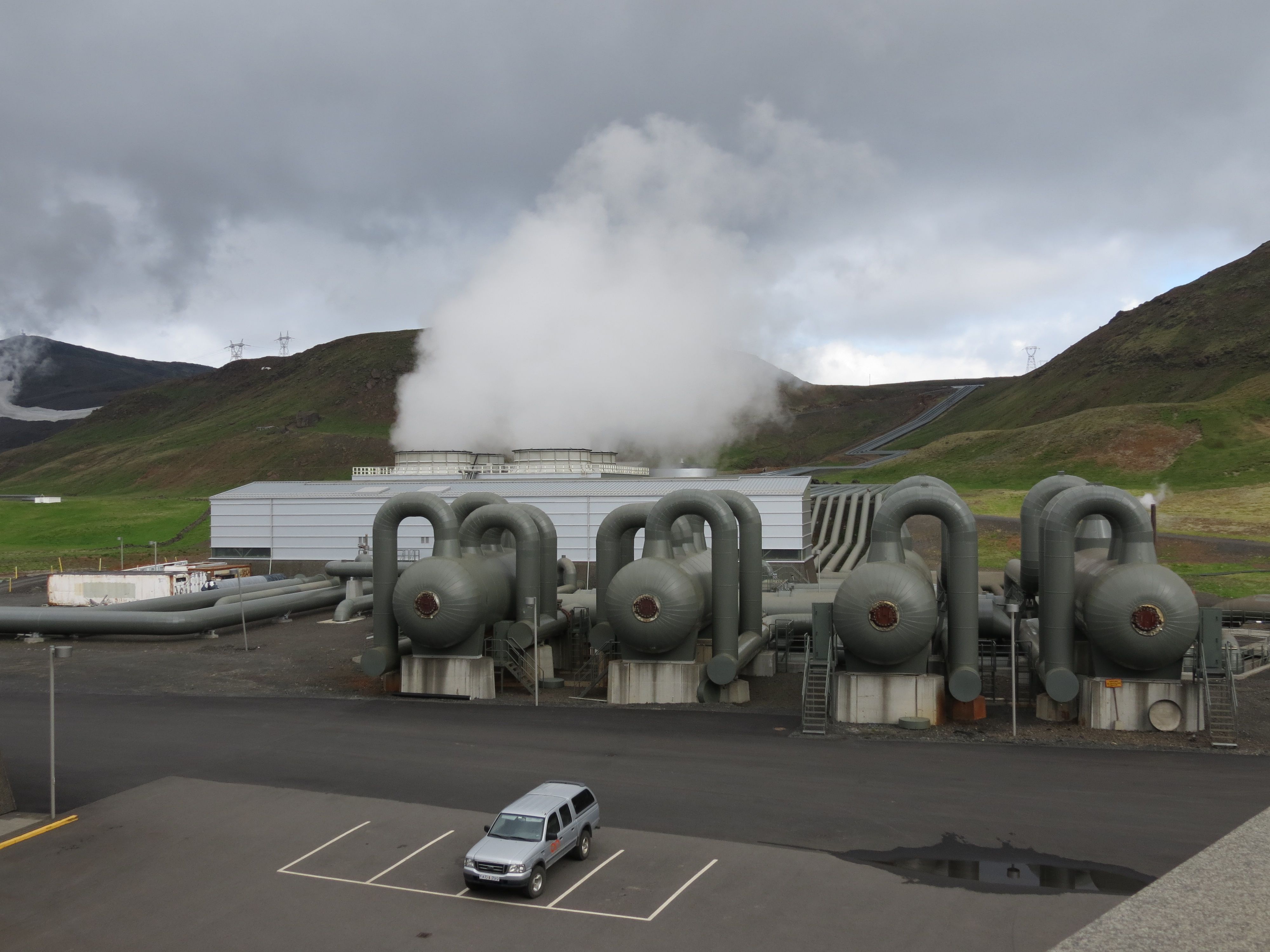
The visitor center had a nice little coffee shop, and we took the opportunity to sample a potent local alcohol made from birch sap: the "snaps" (the Icelandic word for “schnapps”) is called Birkir, it's 36% alcohol by volume, and it had a woody kind of whisky flavor. Not the best whisky I’ve tried, but still very interesting and probably a great gift for someone who enjoys whisky and wants to try something new. We didn’t try the sweet birch liqueur, which is named Björk, but I found myself wondering whether it is a sly reference to Iceland's most famous singer (who doesn’t strike me as particularly saccharine or sappy); more likely, it's just because this is the Icelandic word for the birch trees that are the source of the sap used to create the drink.
If you’ve read this far, you may be wondering whether we spend our trips blundering around in an alcohol-fueled haze. Generally, no. We enjoy beer for its own sake, and therefore sample the local varieties whenever possible, and also enjoy tasting the stronger local tipples. Were it necessary, we’d have no trouble driving legally after most of our impromptu tastings. The exception is when (as happened once) we didn’t pay attention to the label, and found ourselves drinking beer with an 11% alcohol content. (It has a serious kick.) That came as a surprise, and it was probably a good thing we were on foot.
Dick had proposed a group farewell dinner that night, but Shoshanna didn’t like the restaurant he’d proposed (Askur; we’d eaten there before) and also wanted a private dinner. So we walked half an hour from the hotel to town (the harbor district) to try out the restaurant Mar (“March”, not "sea", according to Google Translate). They’d been recommended by the whale watch people who’d given us the tour near the start of our trip, they were whale friendly (serve no whale products of any kind), and got good online ratings, so we gave them a try. Crown rib of lamb for me, which are those small lamb chops with cute little bone projections, kind of like the lamb equivalent of chicken drumsticks; they were tender, savory, and nicely spiced, though a bit salty. Shoshanna enjoyed her seafood au gratin. For dessert, we shared some lava cake (though the waiter insisted they had deliberately refused to use that name in the menu): warm chocolate cake drizzled with chocolate syrup, accompanied by several berries and a scoop of homemade vanilla ice cream. Quite yummy. Beer for dinner was from the Övisholt Brugghús (brewery): Sif for me, a farmhouse-style ale with a darker than usual golden color (and apparently new enough it's not even on the brewery's Web site yet), and Mori for Shoshanna, a fairly typical red ale. The Sif was excellent; the Mori was good but not outstanding.
We had a nice long walk home, taking our time and enjoying the fact that the sunlight hadn’t even slightly faded by the time we arrived back at the hotel, closer to 10 PM than to 9. This midnight sun thing has its advantages.
The next morning was our last day in Iceland, and it was a free day—and beautifully sunny. So we took the hotel shuttle downtown, then had a nice 15-minute walk from the dropoff point to the National Museum. We had a pleasant saunter through the permanent exhibit, which tells the history of Iceland. Though there are obvious differences in the details, it reminded me a lot of the history of Ireland, but with volcanoes: centuries of struggle against a difficult environment, often under the rule of an uncaring and exploitative remote foreign ruler (here, Norway and then Denmark), culminating in an independence made tricky by difficult economic and environmental conditions. My favorite image: the ceremonial coconut chalice (“You’ve got two empty halves of coconuts and you’re banging them together”—Monty Python and the Holy Grail):

On the way home, we paused to admire the City hall’s moss wall under bright sunlight:
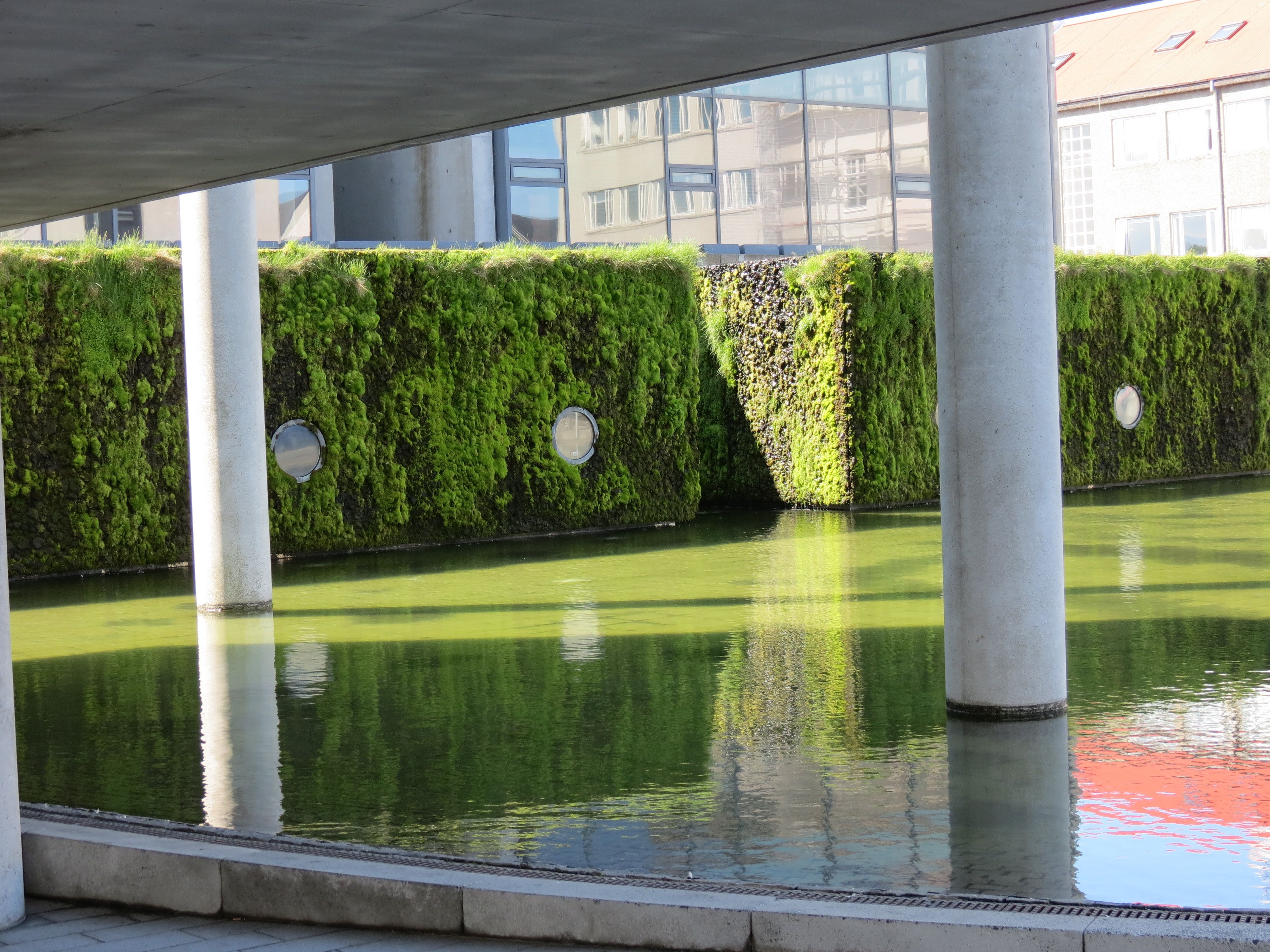
We walked back to the hotel to meet the bus that would bring us to the airport. For most of the way, we passed along Laugevagar street, the main shopping drag. As it was uncharacteristically hot, I was sweating buckets under the bright sun. So when I spotted a café with a large selection of interesting bottles in the window, I proposed that we pause for a quick beer so we could try some final Icelandic beers before leaving. We shared a bottle of Black Death (slogan: “drink in peace”), a thick and bitter dark stout from the Viking Brewery, and Garún, a sweeter dark stout from Iceland’s Borg Brugghús. (Yes, resistance was futile. Borg makes an excellent stout, and some pre-trip research suggests that their other offerings are equally good. Based on the boring bottle label, it seems they’re the same company that made the beers we enjoyed earlier in the trip on the night we forgot to record the beer names. We’ll have to look for them locally to see if they export to Canada.)
We made it back to the hotel with minutes to spare before the bus took us to the airport, where we said our farewells to the rest of the group. The flight home was uneventful only as far as Toronto, where we ran into a 3-hour delay due to equipment failure on our plane. Air Canada tantalized us for the first couple hours with hints that the maintenance crew was working on the problem, then finally gave up and found a replacement plane, which brought us back to Montreal at an indecent hour, exacerbated by the fact that the sun actually sets hereabouts. We finally staggered into bed at 3 AM, surrounded by two very cuddly cats, who wouldn’t let us out of their sight. (Neither bothered to learn the feline “give them the cold shoulder” thing.) Thus, we were both zombies for the next few days, which was unfortunate given the amount of accumulated mail to deal with. (As I’m writing this penultimate blog installment on 11 July, I’m mostly recovered, but still tending to wake up at 5 AM instead of a more reasonable hour.)
One more installment (a summation) will follow in our Icelandic saga before moving on to more mundane issues. Check in tomorrow or Monday to see if I’ve had time.
Final installment: Parting thoughts on Iceland
©2004–2024 Geoffrey Hart. All rights reserved.